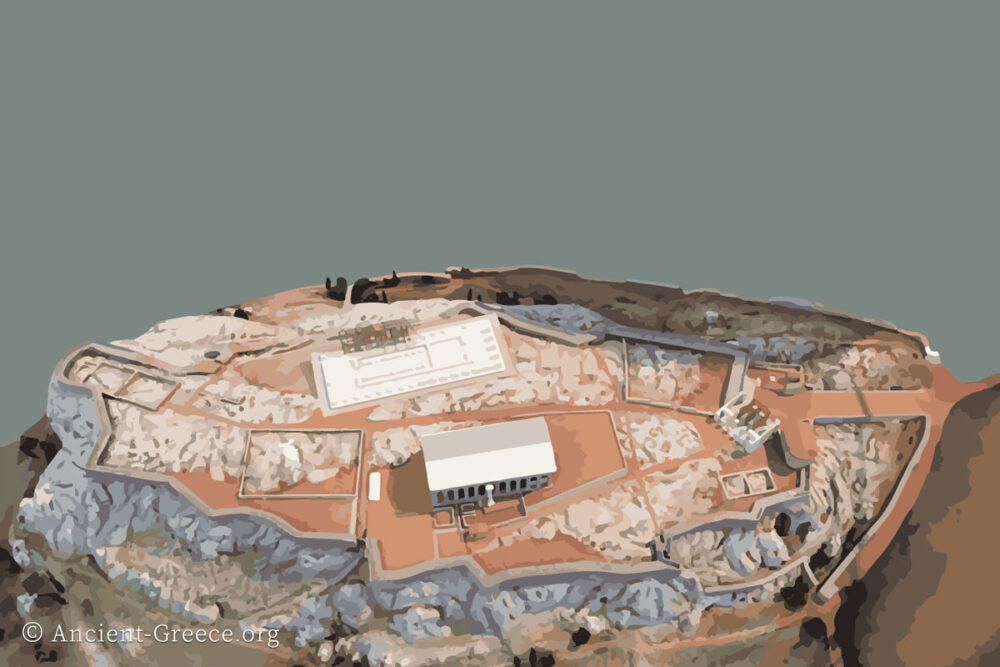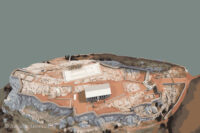
On this page:
7th Century BCE
During the 7th c. BCE monumental sculpture and architecture began its development in mainland through a number of building projects in the Acropolis of Athens, at cape Sounion in the southern tip of Attica and in other sanctuaries around Greece.
At the Acropolis of Athens, a larger Doric temple replaced the temple of Athena from the Geometric era. Since no definitive foundations of this building have been found, its exact location and plan remain unknown.

It was adorned with impressive sculptures on its pediment: two lioness killing two calves, marking the first time a temple was pediment, though only on the East end of the building.
During this period, another temple dedicated to Athena was built at the place of the current Parthenon, and a large ramp was built at the Propylaia.
Solon’s Reforms
Early in the 6th c. BCE Solon created a set of laws for the Athenian citizens abolishing the many debts that burdened the lower classes, and re-organizing the distribution of power. Among other reforms, he allowed thetes (ordinary workers) to participate in court juries, and to be able to appeal sentences.
Solon’s reforms paved the way for further political changes that in time developed to the Democracy that defined Athens during the Classical period.
Eventually, during the next few decades the development of buildings on the Acropolis that included two pediments adorned with sculptures, and a peristyle.
By the early 6th c. BCE the buildings were made of limestone with many parts (especially the roof) built with marble. The subject of the ornamental sculpture of the buildings evolved to include mythological episodes instead of the nature scenes of earlier temples, and at the same time they became increasingly anthropocentric. This was a conceptual departure that was instrumental in the development of Classical art.
Prelude to Classical Era
In the middle of the 6th c. BCE Peisistratos became the most powerful Athenian and he ruled the city with his sons, Hipparchos and Hippias, until his death in 527 BCE.
He curtailed the political influence of the Aristocrats, and limited friction between the classes through tyrannical rule. At the same time he promoted economic growth and promoted the arts through a series of building projects.
During Peisistratos’ rule the old temple of Athena Polias was rebuilt to include a pediment at the west end and marble was introduced as a material at the pediment and the metopes. This new temple was also of the Doric order and it was built of limestone, with the exception of the marble pediment. The sculptures of the temple depicted exclusively mythological events (Gigantomachy), a trend that became prevalent until the classical era.
During the late 6th c. BCE, many smaller buildings and a multitude of statues carved out of marble for the first time were added to the Acropolis. The best-known artwork of this period is the statue of Moschoforos that today is exhibited at the Acropolis museum.
Wealthy aristocrats dedicated a large number of votive Kore statues, and financed most of the building projects of the time as their offering to the gods and the city.
After the death of Peisistratos in 524 BCE, the assassination of Hipparchos in 514 BCE, and the exile of Hippias in 510 BCE, Kleisthenis took power and through far-reaching reforms he paved the way for the first ever Democratic society which began taking shape around 507 BCE.
This History of the Acropolis is divided into the following chapters:
- Introduction
- Prehistoric Acropolis
- Archaic Acropolis
- Classical Acropolis
- Post-Classical Acropolis
- Modern Acropolis
Related Pages

